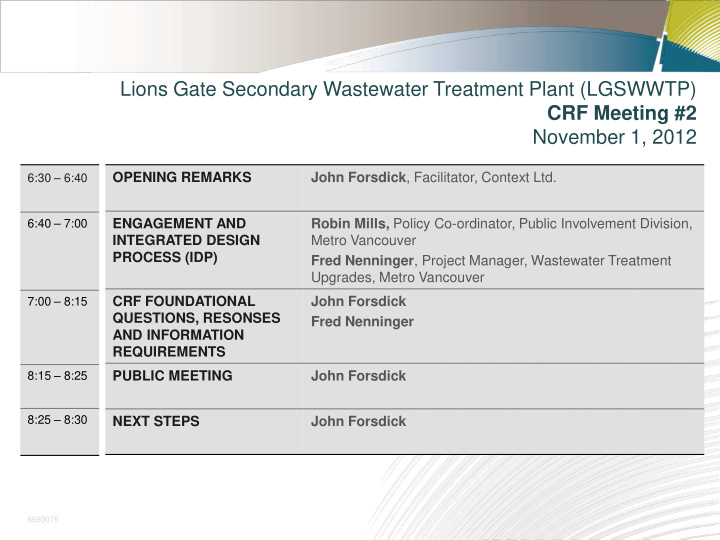



Lions Gate Secondary Wastewater Treatment Plant (LGSWWTP) CRF Meeting #2 November 1, 2012 OPENING REMARKS John Forsdick , Facilitator, Context Ltd. 6:30 – 6:40 ENGAGEMENT AND Robin Mills, Policy Co-ordinator, Public Involvement Division, 6:40 – 7:00 INTEGRATED DESIGN Metro Vancouver PROCESS (IDP) Fred Nenninger , Project Manager, Wastewater Treatment Upgrades, Metro Vancouver CRF FOUNDATIONAL John Forsdick 7:00 – 8:15 QUESTIONS, RESONSES Fred Nenninger AND INFORMATION REQUIREMENTS 8:15 – 8:25 PUBLIC MEETING John Forsdick 8:25 – 8:30 NEXT STEPS John Forsdick 6693075
Engagem ent and I ntegrated Design Process Overview
CRF Foundational Questions and Responses 1 . Regulation 2 . Plant Location 3 . Distributed Treatm ent vs Centralized Treatm ent 4 . Public – Private Partnership 5 . Funding Strategy
Regulations • Updated Integrated Liquid Waste and Resource Management Plan (ILWRMP) approved by Minister in May 2011 • Lions Gate secondary level treatment by 2020
Regulations • Canadian Council of Ministers of the Environment (CCME) Canada-wide Strategy for the Management of Municipal Wastewater Effluent • Endorsed by Ministers in 2009 • ILWRMP aligned with CCME Strategy
Regulations • Wastewater Systems Effluent Regulations – July 2012 • Federal Fisheries Act Regulation – aligned with CCME Strategy • Prescribes four deleterious substances and discharge standards • Harmonization agreements being developed with Provinces
Regulations • Baseline standard of secondary level treatment • Environmental Quality Objectives (EQO) and Environmental Discharge Objectives (EDO) for needs beyond secondary level treatment
Plant Location • Cut-off lands from 1916 • Resolution / legislation in 1980s
Plant Location Cut Off Lands to be returned to Indian Reserve #5. Cut Off Lands returned to Indian Reserve #5 in 1989.
Plant Location
Distributed Treatm ent • Stantec / Dayton Knight Study 2005 • Fidelis Resource Group Study 2011 • No case for distribution without resource recovery • Opportunities for future distribution to be considered by municipalities • Can defer or avoid need to upgrade central plant
P3 Assessm ent is a BC Governm ent Funding Policy Requirem ent “For projects with $ 5 0 Million or m ore of provincial funding, a P3 will be considered the base case unless there is a compelling reason to do otherwise.”
W hat does Partnerships BC/ P3 Canada Consider P3 PBC P3 Canada Private sector involvement Private sector involvement in at least 2 of the in at least 2 of the following: following: Design, Build, Operate, Design, Build, Operate, Maintain, Finance Maintain, Finance 1 of: Finance or Operate/ Maintain
I nfrastructure Delivery Model Spectrum PBC P3 Canada Private Traditional Design/ Bid/ Design Build/ Own DBF DBOM DBFM DBFOM Build / Build / Operate Public Ownership Private Ownership Funding Potentially Available No Funding
I nfrastructure Canada Announcem ent Existing Building Canada Fund Ends in 2014 Approach for a New Long- term Infrastructure Plan
Design and Construction Funding
Recommend
More recommend